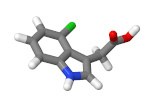
Plant Growth Regulators - Gibberellins (GA) inhibitors
Gibberellins (GAs) are plant hormones that regulate various developmental processes, including stem elongation, germination, dormancy, flowering, flower development, and leaf and fruit senescence. GAs are one of the longest-known classes of plant hormone.
At present, three different groups of inhibitors of GA biosynthesis in higher plants are known:
- "Onium" compounds
- Compounds with a nitrogen-containing heterocycle
- Cyclohexanetriones
Each of these groups inhibits GA biosynthesis at different stages. Three classes of GA-biosynthesis inhibitors that affect different steps in the pathway are known. A well-known example of this class of retardant is chlormequat chloride (CCC), which is used on a large scale as an anti-lodging agent in wheat. Certain heterocyclic nitrogen-containing compounds, including ancymidol, paclobutrazol and tetcyclasis, are efficient inhibitors of ent-kaurene oxidase. The third group of inhibitors comprises acylcyclohexanedione derivatives, such as prohexadione, that target the 2-oxoglutarate-dependent dioxygenases.





